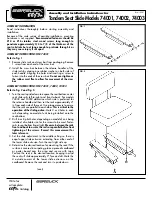
Showing and Hiding the Visual Bumper
The visual bumper is an adjustable perimeter line you can
set around your boat. The visual bumper appears on the
birds-eye view only, and can help you judge how close
objects are to your boat.
From the surround view camera screen, select
Options
>
Visual Bumper
.
Adjusting the Visual Bumper
You must have the visual bumper shown on the bird's-eye
view before you can adjust it.
1
From the surround view camera screen, select
Options
>
Visual Bumper
> .
2
Increase or decrease the range of the visual bumper
line.
3
Select
Back
.
Showing the Distance Marker
You can show the distance marker to gain a better sense
of distance when maneuvering or docking.
The distance markers shown on the bird's-eye view are
determined by the cameras selected in the individual
camera feeds.
From the surround view camera screen, select
Options
>
Distance Marker
.
Renaming a Camera
You can change the name of any camera in the surround
view camera system.
1
From the surround view camera screen, select
Options
>
Rename Cameras
.
2
Select the camera you want to rename.
3
Enter a new name for the camera.
4
Select
Done
.
Device Configuration
System Settings
Select
Options
>
Settings
>
System
.
Sounds and Display
: Adjusts the display settings and the
audio settings (if available).
GPS
: Provides information about the GPS satellites and
settings.
System Information
: Provides information about the
devices on the network and the software version.
Station Information
: Adjusts the setup of the station.
Simulator
: Turns the simulator on or off and allows you to
set the time, date, speed, and simulated location.
Sounds and Display Settings
Select
Options
>
Settings
>
System
>
Sounds and
Display
.
Beeper
: Turns on and off the tone that sounds for alarms
and selections.
Audio Setup
: Sets up the audio output.
Backlight
: Sets the backlight brightness. You can select
the Auto option to adjust the backlight brightness
automatically based on the ambient light.
Color Mode
: Sets the device to display day or night
colors. You can select the Auto option to allow the
device to set day or night colors automatically based
on the time of day.
Startup Image
: Sets the image that appears when you
turn on the device.
Startup Layout
: Sets the layout that appears when you
turn on the device.
Audio Settings
You can adjust audible alarms, alerts, and warnings that
are sounded over connected audio devices, such as a
Fusion stereo. An audio device can be connected using
HDMI or the NMEA 0183 Audio Cable accessory.
Select
Options
>
Settings
>
System
>
Sounds and
Display
>
Audio Setup
.
Audio Output
: Turns on the audio output for audio alerts.
Audio Alerts
: Sets which system alarms and alerts are
played over the compatible audio output. An alarm
indicates a situation could be hazardous to passengers
and requires immediate action. A warning indicates
the situation could be hazardous to equipment on the
vessel or the vessel itself and requires action very
soon. All other messages and information are classified
as alerts.
Audio Alert Language
: Sets the spoken language for
alerts.
Audio Alert Device
: Sets the device to control when
alerts are played.
Audio Alert Source
: Switches the audio device to the
selected source when an alert is played.
Alert Volume
: Controls the volume of the alerts.
GPS Settings
NOTE:
Not all options are available on all models.
Select
Options
>
Settings
>
System
>
GPS
.
Skyview
: Shows the relative position of GPS satellites in
the sky.
GLONASS
: Turns on or off GLONASS data (Russia
satellite system). When the system is used in situations
with poor sky visibility, GLONASS data can be used
in combination with GPS to provide more accurate
position information.
WAAS/EGNOS
: Turns on or off WAAS data (in North
America) or EGNOS data (in Europe), which can
provide more-accurate GPS position information. When
using WAAS or EGNOS data, the device may take
longer to acquire satellites.
Galileo
: Turns on or off Galileo data (European Union
satellite system). When the system is used in situations
with poor sky visibility, Galileo data can be used
in combination with GPS to provide more accurate
position information.
Device Configuration
81
















































